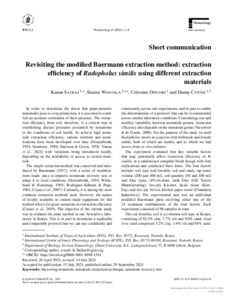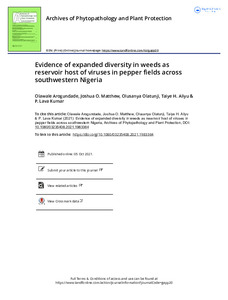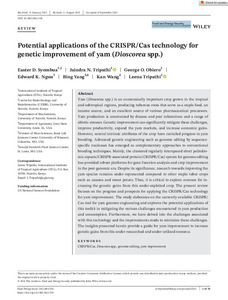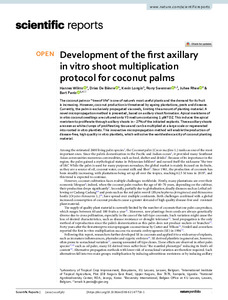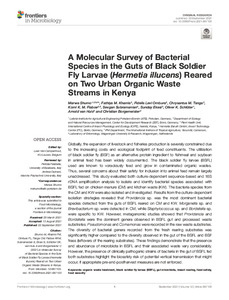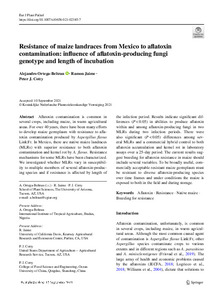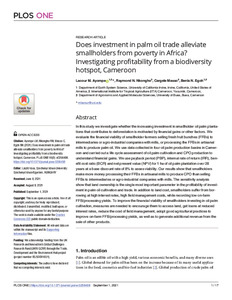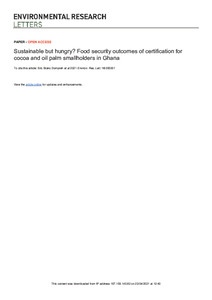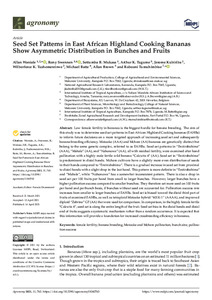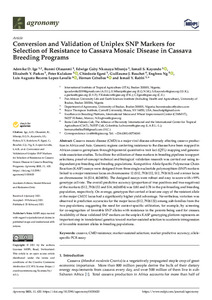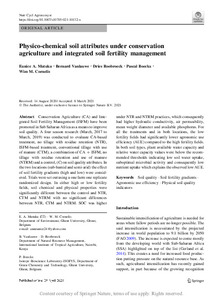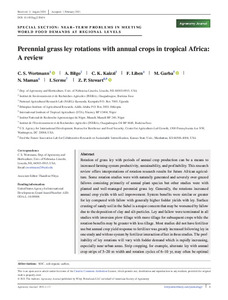Welcome to the International Institute of Tropical Agriculture Research Repository
IITA Bibliography System: Recent submissions
Now showing items 861-880 of 8099
-
New sources and stability of resistance to aphids in cowpea germplasm across locations in Uganda
(2021)The cowpea aphid (Aphis craccivora Koch) is an economically important pest, whose feeding effects cause stunting, delayed flower initiation and yield reduction in cowpea (Vigna unguiculata L. Walp). Host plant resistance offers an alternative for controlling aphids; while simultaneously reducing reliance on chemical pesticides. The objective of this study was to evaluate a multi-parent advanced generation inter-cross (MAGIC) population of cowpea against aphids, across cowpea growing regions in ... -
Revisiting the modified Baermann extraction method: extraction efficiency of Radopholus similis using different extraction materials
(2021-09-29)In order to determine the threat that plant-parasitic nematodes pose to crop production, it is essential to establish an accurate estimation of their presence. The extraction efficiency from soil, therefore, is a critical step in establishing disease pressures presented by nematodes or the conditions of soil health. To achieve high nematode extraction efficiency, various methods and modifications have been developed over time (Oostenbrink, 1954; Seinhorst, 1956; Harrison & Green, 1976; Viaene et ... -
Diversity of nematodes on banana (Musa spp.) in Kenya linked to altitude and with a focus on the pathogenicity of Pratylenchus goodeyi
(2021-08-30)Summary Bananas (Musa spp.) are considered the most important fruit crop in Kenya, grown mostly by smallholder farmers. However, in the past two decades production has declined and has largely been attributed to plant pathogens, including plant-parasitic nematodes. To assess the understanding and awareness that banana farmers have of nematodes, a survey was conducted. The incidence, abundance and distribution of nematodes in relation to altitude were determined for different banana types on 180 ... -
Evidence of expanded diversity in weeds as reservoir host of viruses in pepper fields across southwestern Nigeria
(2021-10-05)This study aimed to investigate virus occurrence in weed species in the main pepper-growing areas in Southwest Nigeria. The weed samples collected from pepper farms were identified and subjected to Antigen-Coated Plate Enzyme-Linked Immunosorbent Assay using antibodies specific eight different viruses. Results showed that the Weed species collected contain 17 families, 33 genera and 36 plant species of which 83.33% of the plant species tested positive to one or more plant viruses. The results ... -
First report of banana bunchy top virus in banana and plantain (Musa spp.) in Tanzania
(2022-04)Banana (including plantain; Musa spp.) is an important vegetatively propagated food staple grown as a semi-perennial crop in fields and backyard gardens in Tanzania. Banana bunchy top disease (BBTD), caused by the banana bunchy top virus (BBTV, genus Babuvirus), is the most economically important viral disease of banana, infection of which results in severe stunting and reduction in fruit production by 90-100% within two seasons. The virus is spread by the banana aphid, Pentalonia nigronervosa, ... -
Potential applications of the CRISPR/Cas technology for genetic improvement of yam (Dioscorea spp.)
(2021-09)Yam (Dioscorea spp.) is an economically important crop grown in the tropical and subtropical regions, producing tuberous roots that serve as a staple food, an income source, and an excellent source of various pharmaceutical precursors. Yam production is constrained by disease and pest infestations and a range of abiotic stresses. Genetic improvement can significantly mitigate these challenges, improve productivity, expand the yam markets, and increase economic gains. However, several intrinsic ... -
Development of the first axillary in vitro shoot multiplication protocol for coconut palms
(2021)The coconut palm or “tree of life” is one of nature’s most useful plants and the demand for its fruit is increasing. However, coconut production is threatened by ageing plantations, pests and diseases. Currently, the palm is exclusively propagated via seeds, limiting the amount of planting material. A novel micropropagation method is presented, based on axillary shoot formation. Apical meristems of in vitro coconut seedlings are cultured onto Y3 medium containing 1 µM TDZ. This induces the apical ... -
A molecular survey of bacterial species in the guts of black soldier fly larvae (Hermetia illucens) reared on two urban organic waste streams in Kenya
(2021-09-22)Globally, the expansion of livestock and fisheries production is severely constrained due to the increasing costs and ecological footprint of feed constituents. The utilization of black soldier fly (BSF) as an alternative protein ingredient to fishmeal and soybean in animal feed has been widely documented. The black soldier fly larvae (BSFL) used are known to voraciously feed and grow in contaminated organic wastes. Thus, several concerns about their safety for inclusion into animal feed remain ... -
Stem borers of cereal crops in Africa and their management
(IntechOpen, 2020)The economic importance of the stem borer in Africa results in their severe damage that affect directly cereal yield factors such as the density of fertile tillers and the number of effective panicles. The objective of this paper is to describe and discuss the management options of the main prevalent stem borer of cereal crops in Africa. Host plant resistance, cultural practices, biological control and reasoning chemical control are among the most encouraging options. Integrated pest management ... -
Contributions of integrated aflatoxin management strategies to achieve the sustainable development goals in various African countries
(2021-09)In 2015, all United Nations Member States adopted the 2030 Agenda for Sustainable Development to achieve peace and prosperity for all people in the planet. Meeting that ambitious agenda depends on fulfilling all objectives of 17 Sustainable Development Goals (SDGs). Multiple approaches by diverse actors, many of them interconnected, will allow achieving each SDG. However, with compromised food security and food safety, many SDGs will not be realized. In sub-Saharan Africa (SSA), maize and groundnut ... -
Resistance of maize landraces from Mexico to aflatoxin contamination: influence of aflatoxin-producing fungi genotype and length of incubation
(2021-09-15)Aflatoxin contamination is common in several crops, including maize, in warm agricultural areas. For over 40 years, there have been many efforts to develop maize germplasm with resistance to aflatoxin contamination produced by Aspergillus flavus Link:Fr. In Mexico, there are native maize landraces (MLRs) with superior resistance to both aflatoxin contamination and kernel rot by A. flavus. Resistance mechanisms for some MLRs have been characterized. We investigated whether MLRs vary in susceptibility ... -
Tools to assess gender inequalities in access to and benefits derived from the cassava seed system
(International Institute of Tropical Agriculture, 2021) -
Does investment in palm oil trade alleviate smallholders from poverty in Africa? Investigating profitability from a biodiversity hotspot, Cameroon
(2021)In this study we investigate whether the increasing investment in smallholder oil palm plantations that contributes to deforestation is motivated by financial gains or other factors. We evaluate the financial viability of smallholder farmers selling fresh fruit bunches (FFBs) to intermediaries or agro-industrial companies with mills, or processing the FFBs in artisanal mills to produce palm oil. We use data collected in four oil palm production basins in Cameroon and carried out a life cycle ... -
Efficacy of nutrient management options for finger millet production on degraded smallholder farms in eastern Uganda
(2021-09)Poor soil fertility is a major problem constraining crop productivity in smallholder farms of sub-Saharan Africa due to inadequate nutrient replenishment. Differential management of nutrients creates areas of accumulation and depletion of nutrients within farms with the latter increasing in spatial coverage. Nutrient additions are required to increase crop production in such degraded areas. We used experimental data to evaluate the potential of inorganic fertilizers and organic manures to offset ... -
Sustainable but hungry? Food security outcomes of certification for cocoa and oil palm smallholders in Ghana
(2021)Cocoa and oil palm are the major commodity crops produced in Ghana and livelihood options for hundreds of thousands of rural households. However, their production has negative environmental and socioeconomic impacts. Certification standards have been promoted as a market-led mechanism to ensure their sustainable production. Even though food security does not feature in the theory of change of most certification standards, there are interesting intersections. This paper assesses the food security ... -
Seed set patterns in east African highland cooking bananas show asymmetric distribution in bunches and fruits
(2021)Low female fertility in bananas is the biggest hurdle for banana breeding. The aim of this study was to determine seed set patterns in East African Highland Cooking bananas (EAHBs) to inform future decisions on a more targeted approach of increasing seed set and subsequently banana-breeding efficiency. Matooke (AAA) and Mchare (AA) bananas are genetically distinct but belong to the same genetic complex, referred to as EAHBs. Seed set patterns in “Enzirabahima” (AAA), “Mshale” (AA), and “Nshonowa” ... -
Conversion and validation of uniplex SNP markers for selection of resistance to Cassava Mosaic Disease in Cassava breeding programs
(2021)Cassava mosaic disease (CMD) is a major viral disease adversely affecting cassava production in Africa and Asia. Genomic regions conferring resistance to the disease have been mapped in African cassava germplasm through biparental quantitative trait loci (QTL) mapping and genome-wide association studies. To facilitate the utilization of these markers in breeding pipelines to support selections, proof-of-concept technical and biological validation research was carried out using independent pre-breeding ... -
Physico-chemical soil attributes under conservation agriculture and integrated soil fertility management
(2021)Conservation Agriculture (CA) and Integrated Soil Fertility Management (ISFM) have been promoted in Sub Saharan Africa as a means to improve soil quality. A four season research (March, 2017 to March, 2019) was conducted to evaluate CA-based treatment, no tillage with residue retention (NTR), ISFM-based treatment, conventional tillage with use of manure (CTM), a combination of CA + ISFM, no tillage with residue retention and use of manure (NTRM) and a control, (C) on soil quality attributes. In ... -
The Seeds: Start Them Early Program
(IInternational Institute of Tropical Agriculture, 2022-07) -
Perennial grass ley rotations with annual crops in tropical Africa: a review
(2021)Rotation of grass ley with periods of annual crop production can be a means to increased farming system productivity, sustainability, and profitability. This research review offers interpretations of rotation research results for future African agriculture. Some rotation studies were with naturally generated and severely over-grazed fallows consisting primarily of annual plant species but other studies were with planted and well-managed perennial grass ley. Generally, the rotations increased annual ...


